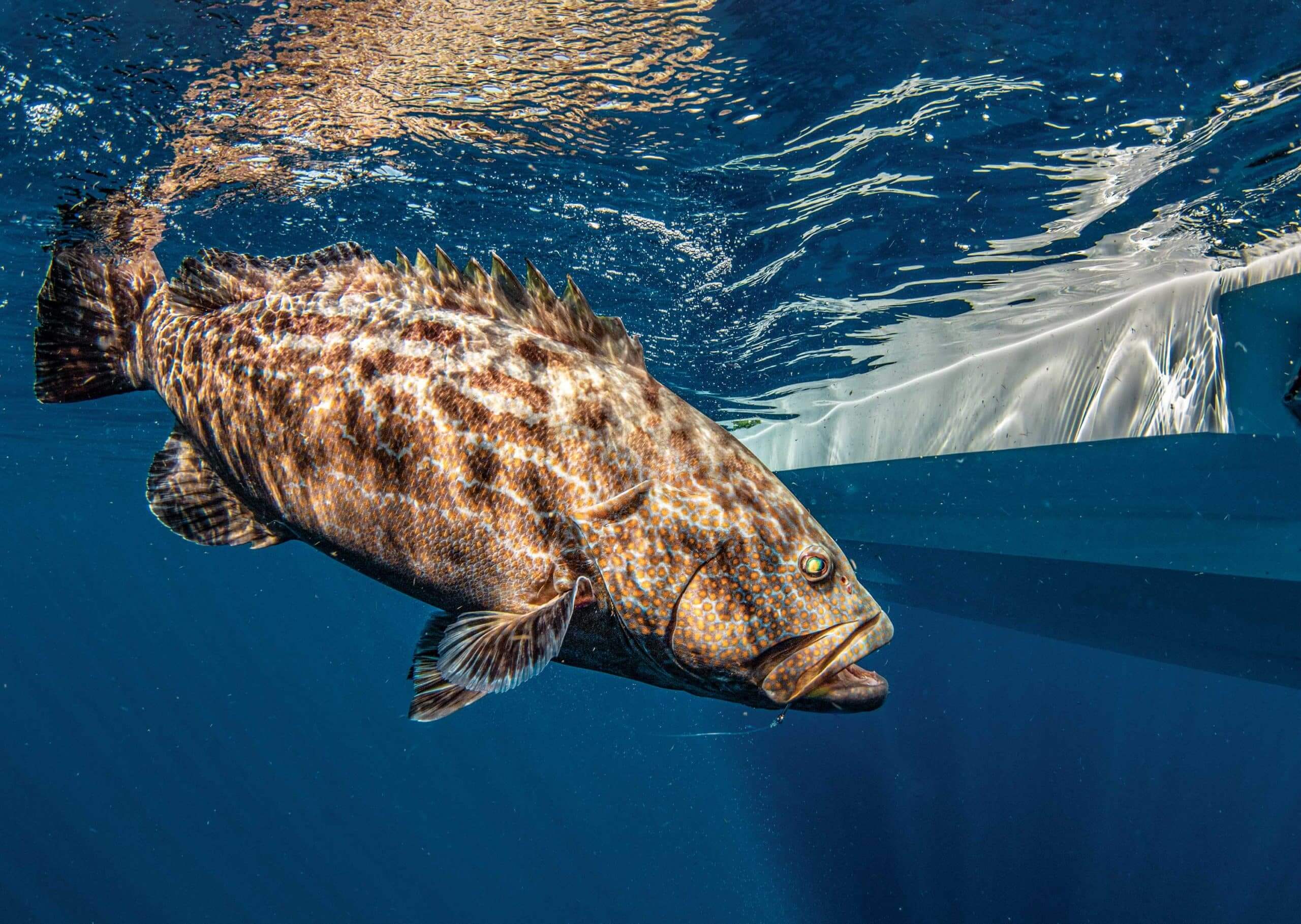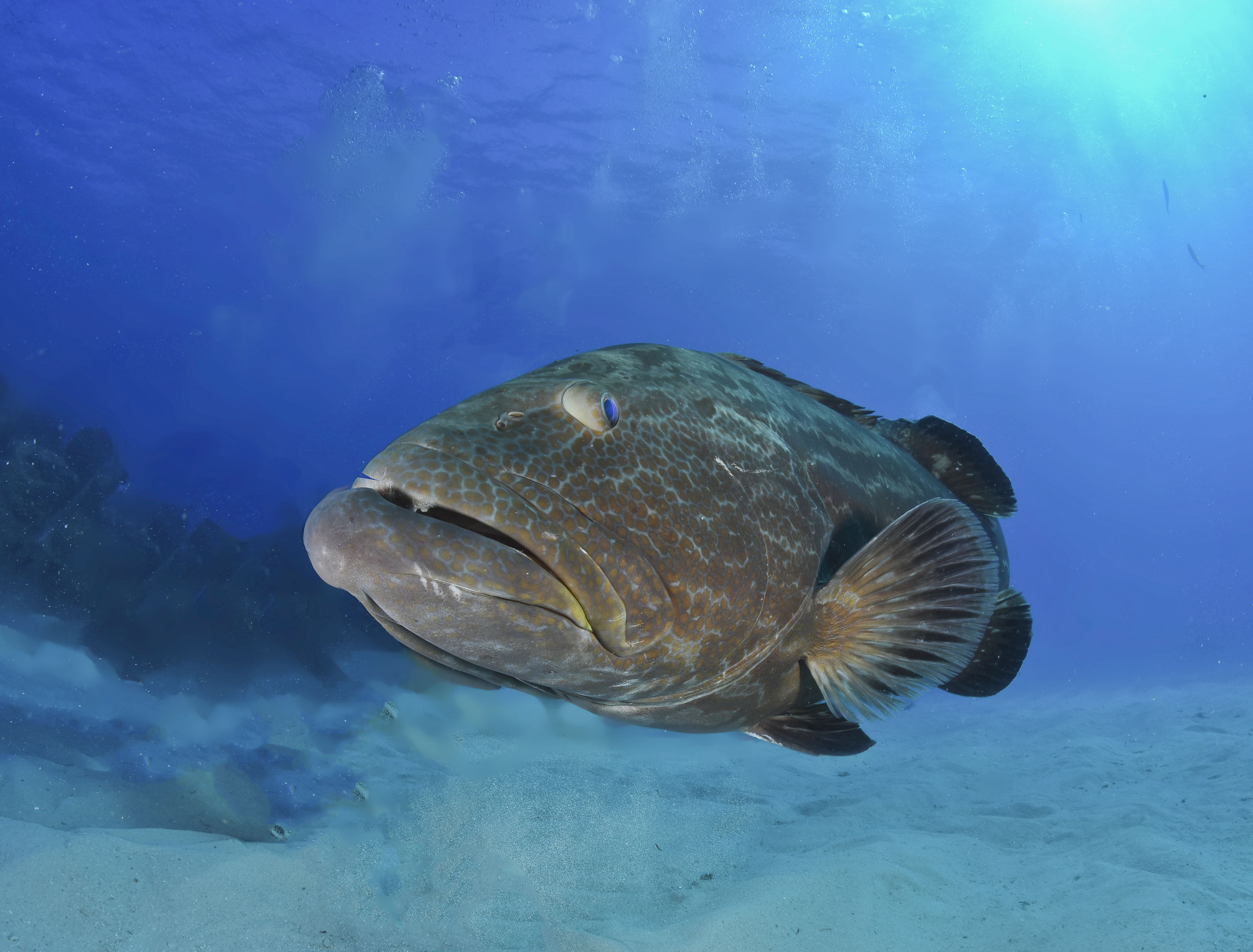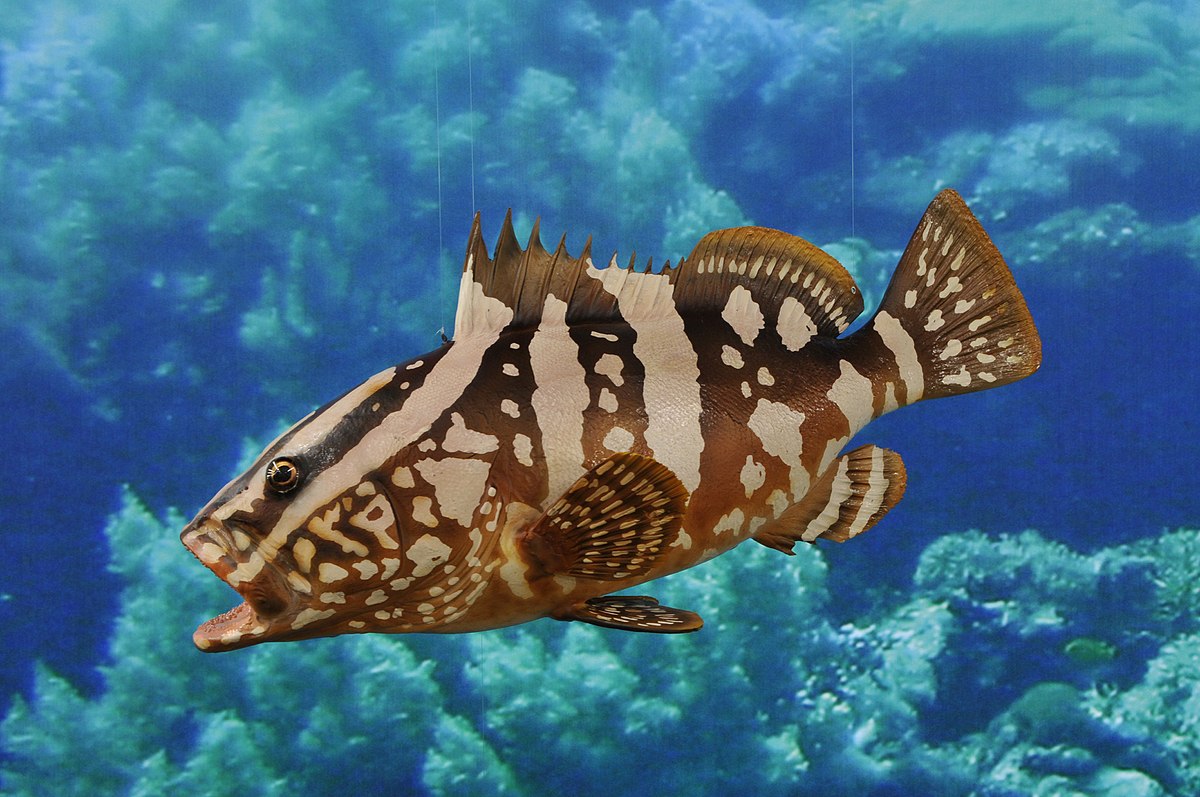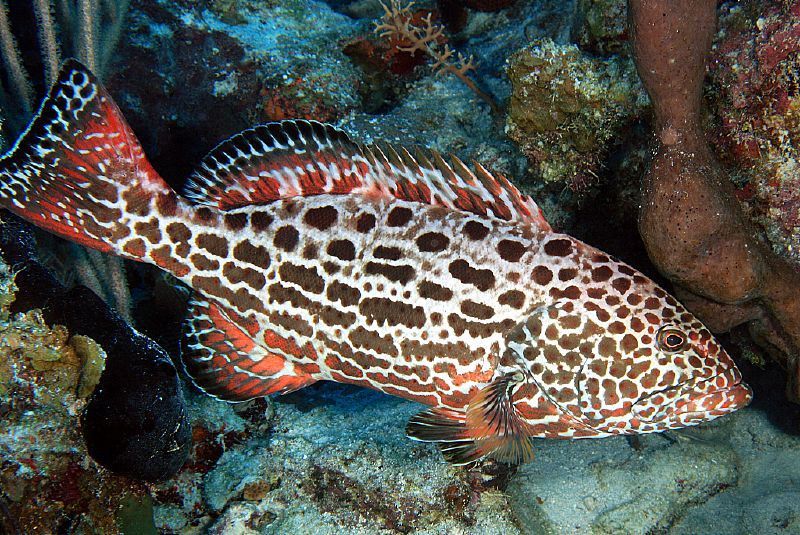Grouper is a type of saltwater fish that is known for its large size, powerful body, and delicious taste. There are many species of grouper, and they vary in size depending on the species.
Some smaller species measure only 12 inches in length, while larger species grow several feet and can weigh hundreds of pounds. In this article, we will explore the ten biggest types of grouper fish. These fish are not only impressive in size, but they are also fascinating creatures that inhabit the world’s oceans.
You are reading: Discover 10 Biggest Types Of Grouper Fish

10 Biggest Types Of Grouper Fish
Atlantic Goliath Grouper

The Atlantic goliath grouper, also known as the jewfish, is a species of saltwater fish that belongs to the grouper family. It is one of the largest species of bony fish, and it can be found in the Atlantic Ocean.
The Atlantic goliath grouper can grow up to 8.2 feet in length and weigh up to 800 pounds. The species ranges in coloration from brownish yellow to grey to greenish and has small black dots on the head, body, and fins. The lower jaw has 3 to 5 rows of teeth with no front canines.
The Atlantic goliath grouper is an ambush predator that feeds on large fishes, invertebrates, and even small sharks. It is found primarily in shallow tropical waters among coral and artificial reefs, including the Gulf of Mexico, the Florida Keys, the Bahamas, most of the Caribbean, and most of the Brazilian coast.
The Atlantic goliath grouper is a slow-growing species that has been overfished in the past, leading to a decline in its population. As a result, it is now protected in many areas.
Black Grouper

The black grouper, also known as Mycteroperca bonaci, is a species of marine fish that belongs to the grouper family. It is a large fish that can grow up to five feet in length and weigh up to 180 pounds.
Black groupers are found in the western Atlantic from Massachusetts to Brazil and are particularly associated with the southern Gulf of Mexico, Florida Keys, Cuba, the Bahamas, and throughout the Caribbean. They have an olive or gray body, with black blotches and brassy spots, and their cheeks are gently rounded.
Black groupers are ambush predators that use their large, powerful jaws to suck up their prey, which can include fish and crustaceans. They are also known to take advantage of other species’ reproductive aggregations for feeding.
Black groupers are born female, but some transform into males when they are large enough. They spawn during the winter months and are protogynous hermaphrodites, meaning that young predominantly female who transform into males as they grow larger.
Read more : Discover The Top 3 Largest And Most Dangerous Snakes In Colorado
Black grouper is a smart seafood choice because it is sustainably managed and responsibly harvested under U.S. regulations.
Warsaw Grouper
The Warsaw grouper, also known as Hyporthodus nigritus, is a species of marine fish that belongs to the grouper family. It is a deep-water fish that inhabits reefs on the continental shelf break in waters 180 to 1700 feet deep.
The Warsaw grouper is the only member of the genus Epinephelous that has 10 dorsal spines, the second of which is much longer than the third. The species ranges from Massachusetts to the Gulf of Mexico, Cuba, Trinidad, and south to Brazil.
The Warsaw grouper can grow up to 6 feet in length and weigh over 300 pounds. It has a mottled dark reddish-brown or grayish coloration with a uniform coloring across the body.
The Warsaw grouper is a slow-growing species that can live up to 41 years and is a protogynous hermaphrodite, meaning that it changes sex from female to male as it matures.
The species feeds on fishes, crustaceans, and other prey. The Warsaw grouper is a US National Marine Fisheries Service species of concern, and it is threatened by habitat loss and overfishing. The species is currently closed to possession or harvest in some areas.
Goliath Grouper
The Atlantic goliath grouper, also known as the jewfish, is a species of saltwater fish that belongs to the grouper family. It is one of the largest species of bony fish, and it can be found in the Atlantic Ocean.
The Atlantic goliath grouper can grow up to 8.2 feet in length and weigh up to 800 pounds. The species ranges in coloration from brownish yellow to grey to greenish and has small black dots on the head, body, and fins. The lower jaw has 3 to 5 rows of teeth with no front canines.
The Atlantic goliath grouper is an ambush predator that feeds on large fishes, invertebrates, and even small sharks. It is found primarily in shallow tropical waters among coral and artificial reefs, including the Gulf of Mexico, the Florida Keys, the Bahamas, most of the Caribbean, and most of the Brazilian coast.
The Atlantic goliath grouper is a slow-growing species that has been overfished in the past, leading to a decline in its population. As a result, it is now protected in many areas.
Misty Grouper
The misty grouper, also known as Hyporthodus mystacinus, is a species of marine fish that belongs to the grouper family. Here are some interesting facts about the misty grouper:
– Misty grouper are a deep-bodied grouper with 6-9 prominent brown vertical bars along its sides.
– This large grouper species can typically be found along deepwater rocks and ledges throughout the Gulf of Mexico, Caribbean Sea, and the Western Atlantic edges.
– The misty grouper can grow up to 63 inches in length and weigh up to 160 pounds.
– It is a solitary, deep-water species that is reported to be found from 100-400 meters deep, with juveniles sometimes in water as shallow as 30 meters.
– The misty grouper feeds on fishes, crustaceans, and squids.
– The species is primarily found in the Caribbean and the Gulf of Mexico, with populations present around the Galapagos Islands and Central American coastlines.
– The misty grouper is also known as the black grouper, convict grouper, eightbar grouper, or moustache grouper.
– The misty grouper is a popular gamefish and is highly sought after by recreational anglers.
– The species is currently not listed as endangered or threatened, but it is important to manage the population to ensure its sustainability.
Overall, the misty grouper is a fascinating species of fish that is highly valued by anglers and plays an important role in the marine ecosystem.
Yellowedge Grouper
The yellowedge grouper, also known as Hyporthodus flavolimbatus, is a species of marine fish that belongs to the grouper family. Here are some interesting facts about the yellowedge grouper:
– The yellowedge grouper is found in deep waters of the western Atlantic from North Carolina to Brazil, including the Gulf of Mexico and Caribbean Sea.
– This species can grow up to 3 feet in length and weigh up to 50 pounds.
– Yellowedge grouper are managed under an individual fishing quota (IFQ) program, and anyone commercially fishing for yellowedge grouper must possess an IFQ permit.
– The species is a popular target for deep-drop fishing and is known for its delicious taste.
– Yellowedge grouper feed on a variety of prey, including fishes, crustaceans, and squids.
– The use of a dehooking tool is required when fishing for or possessing snapper grouper species in federal waters of the South Atlantic.
– The yellowedge grouper is a slow-growing species that is vulnerable to overfishing, and it is important to manage the population to ensure its sustainability.
– The species is not currently listed as endangered or threatened, but it is important to monitor the population to ensure its long-term survival.
Overall, the yellowedge grouper is a fascinating species of fish that is highly valued by commercial and recreational fishermen. It is important to manage the population to ensure its sustainability and to protect the species from overfishing.
Snowy Grouper
Read more : The Top 10 Fluffy Furry Fuzzy Moths In The World
The snowy grouper is a species of marine fish that belongs to the grouper family. Here are some interesting facts about the snowy grouper:
– The snowy grouper is found in the western Atlantic Ocean, including the Gulf of Mexico, the Caribbean Sea, and the eastern coast of the United States from Massachusetts to Florida.
– This species can grow up to 3 feet in length and weigh up to 70 pounds.
– The snowy grouper has a robust, compressed, oval body with a notable convex upper edge of the gill cover. Its coloration varies with the size of the fish, with smaller fish being dark brown overall with coin-size pearly white spots on the sides, while larger fish lose the white spots and become dark brown with a slight coppery tint.
– Snowy groupers are bottom fish that are found in deep waters of up to 1,722 feet over rock substrates in offshore waters, although they are most common between 300 and 600 feet.
– The species is predatory and feeds on fishes, gastropods, cephalopods, and brachyuran crustaceans.
– Snowy groupers are protogynous hermaphrodites, meaning that they change sex from female to male as they mature. They spawn from May to June and release more than 2 million eggs.
– The snowy grouper is targeted by commercial fisheries in the United States, Central America, and South America using hook-and-line, bottom longlines, traps, and trawls.
– Regulations for the snowy grouper vary by location, but the species is currently closed to possession or harvest in some areas.
Overall, the snowy grouper is a fascinating species of fish that is highly valued by commercial and recreational fishermen. It is important to manage the population to ensure its sustainability and to protect the species from overfishing.
Nassau Grouper

The Nassau grouper, also known as Epinephelus striatus, is a species of marine fish that belongs to the grouper family. Here are some interesting facts about the Nassau grouper:
– The Nassau grouper is a reef fish that is a member of the family Serranidae, which includes groupers valued as a major fishery resource such as the gag.
– The species is found in the western Atlantic Ocean and around the Caribbean Sea, from Bermuda, Florida, and the Bahamas in the north to the eastern coast of Venezuela, but it is only found in a few places in the Gulf of Mexico, most notably along the coast of Belize.
– The Nassau grouper is a medium to large fish that can grow over a meter in length and up to 25 kg in weight.
– The species has a thick body and large mouth, which it uses to inhale prey. Its color varies depending on an individual fish’s circumstances and environment. In shallow water (down to 60 ft), the grouper is a tawny color, but specimens living in deeper waters are pinkish or red, or sometimes orange-red in color.
– Nassau grouper are ambush predators that are not selective with their prey. They swallow prey whole using a suction created by their protruding mouth. Their mouth size determines the size of fish they eat. Adults eat only fish, while juveniles eat a variety of fish and invertebrates such as shrimp and crabs.
– The Nassau grouper is fished both commercially and for sport, and it is less shy than other groupers, making it readily approachable by scuba divers.
– The species has been overfished in recent years, leading to a decline in its population. As a result, it is now listed as critically endangered by the International Union for Conservation of Nature and is a US National Marine Fisheries Service listed threatened species by authority of the Endangered Species Act of 1973.
– Currently, all harvest of Nassau grouper is prohibited in the United States, and fishing the species is prohibited in US federal waters.
– The Nassau grouper is a slow breeder, and its numbers have been sharply reduced by overfishing in recent years.
– The protection and sustainable management of coral reefs, mangroves, and seagrass beds are necessary to strengthen the coastal resilience of the Caribbean region, and the inscription of protected areas within the SPAW Protocol is a priority for stakeholders.
Red Grouper
The red grouper, also known as Epinephelus morio, is a species of marine fish that belongs to the grouper family. Here are some interesting facts about the red grouper:
– The red grouper is found in the western Atlantic Ocean, from southern Brazil to North Carolina in the US, including the Gulf of Mexico and Bermuda.
– This species can grow up to 125 cm in length and weigh up to 23 kg or more.
– The red grouper’s typical range is coastal areas in the western Atlantic, stretching from southern Brazil to North Carolina in the US and including the Gulf of Mexico and Bermuda.
– Red grouper are bottom-dwelling fish that are found over hard and muddy bottoms, and juveniles can be found offshore along with adults greater than 6 years old.
– The species is a demersal, largely sedentary species that has an extended (~40 day) pelagic larval stage before it settles in shallow coastal hardbottom habitat as juveniles. They remain in inshore waters for 4–5 years before migrating to offshore hardbottom habitat—particularly on the edge of the continental self—as adults. Spawning occurs offshore between January and June, peaking in May.
– Red grouper are unspecialized and opportunistic feeders, and they eat any convenient prey. They engulf prey whole by opening their large mouths, dilating their.
– The red grouper is a protogynous hermaphrodite, meaning that it changes sex from female to male as it matures. Females are capable of reproducing at 4 years of age, and spawning takes place from March to July.
– The species is fished both commercially and for sport, and it is known for its mild but distinct flavor, somewhere between bass and halibut.
– Populations of red grouper are considered overfished and undergoing overfishing in the northeastern and southern portions of the Gulf of Mexico with large declines in some areas. Harvest in US waters has decreased by over 50% in the last 55 years.
– The red grouper is a robust fish of moderate size, with large eyes and the pelvic fins inserted posterior to the pectoral fins on the body. The head and the body of the red grouper are dark reddish-brown in color fading to a pink or reddish color on the lateral sides and ventral side. Light-colored blotches and spots may be seen scattered on the body, and small black dots may be present around the eyes.
Overall, the red grouper is a fascinating species of fish that is highly valued by commercial and recreational fishermen. It is important to manage the population to ensure its sustainability and to protect the species from overfishing.
Yellowfin Grouper

The yellowfin grouper is a species of marine fish that belongs to the grouper family. Here are some interesting facts about the yellowfin grouper:
Appearance:
– The yellowfin grouper has an elongate, robust, and compressed body, with a depth that is no greater at the origin of the dorsal fin as it is at the origin of the anal fin.
– The standard length is 2.6 to 2.9 times the depth of the body.
– The preopercle is neatly rounded, sometimes having a small incision, and does not have a lobe at its angle.
– The dorsal fin contains 11 spines and 15-16 soft rays while the anal fin contains 3 spines and 10-12 soft rays.
– The body is greenish-olive or bright red, and oval groups of dark spots form horizontal rows on the body. The outer third of pectoral fins are bright yellow.
Habitat:
– The yellowfin grouper is found in the western Atlantic Ocean, from North Carolina south to Florida and into the Gulf of Mexico where it occurs in the Florida Keys and the Flower Garden Banks National Marine Sanctuary in Texas south through the Bahamas into the West Indies and the Yucatan Peninsula in Mexico. It is also found around Bermuda. Along the Caribbean coast of South America, it occurs as far east as French Guiana.
– The species is found over rocky or coral reefs as adults, and juveniles are found in beds of turtle grass. This species has also been caught by trawlers over muddy bottoms in the Gulf of Mexico. Its depth range is 2 to 137 meters (6.6 to 449.5 ft).
Behavior:
– The yellowfin grouper is a protogynous hermaphrodite, meaning that it changes sex from female to male as it matures. Females reach sexual maturity at a fork length around 51 centimeters (20 in) and at around 4.6 years old. They will then change sex to male at a fork length of 80.1 centimeters (31.5 in).
– The species forms spawning aggregations, and these occur at different times and locations depending on the region.
– The yellowfin grouper feeds mainly on fishes (mostly on coral reef species) and squids.
Conservation:
– The yellowfin grouper is a desirable food fish, and even large individuals are heavily fished in some areas.
– The species is not currently listed as endangered or threatened, but it is important to manage the population to ensure its sustainability.
FAQS
1. What are the 10 biggest types of grouper fish?
The 10 biggest types of grouper fish are the Atlantic Goliath Grouper, Queensland Grouper, Nassau Grouper, Tiger Grouper, Black Grouper, Yellowedge Grouper, Warsaw Grouper, Snowy Grouper, Comet Grouper, and the Yellowfin Grouper.
2. How big can grouper fish grow?
Grouper fish vary in size depending on the species. Some smaller species measure only 12 inches in length, while larger species grow several feet and can weigh hundreds of pounds.
3. What do grouper fish eat?
Grouper fish are opportunistic feeders and eat any convenient prey. They feed on fishes, crustaceans, and squids.
4. Do grouper fish live in groups?
Some species of grouper fish live in groups, while others are solitary.
5. Where can grouper fish be found?
Grouper fish can be found in various habitats, including reefs, rocky areas, and coral formations. They are commonly found in both saltwater and freshwater environments, including the western Atlantic Ocean, the Gulf of Mexico, and the Caribbean Sea.
Source: https://petstutorial.com
Category: Animals










